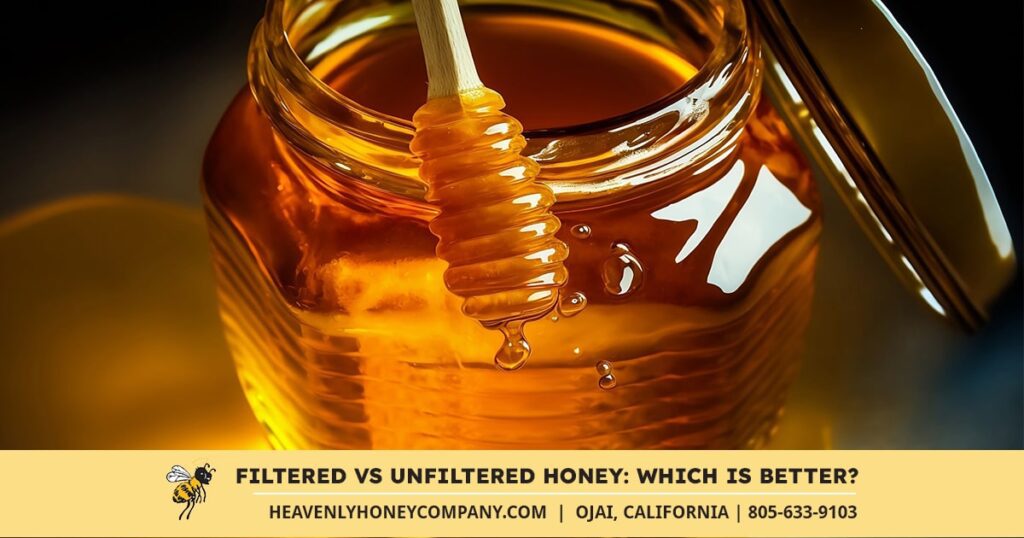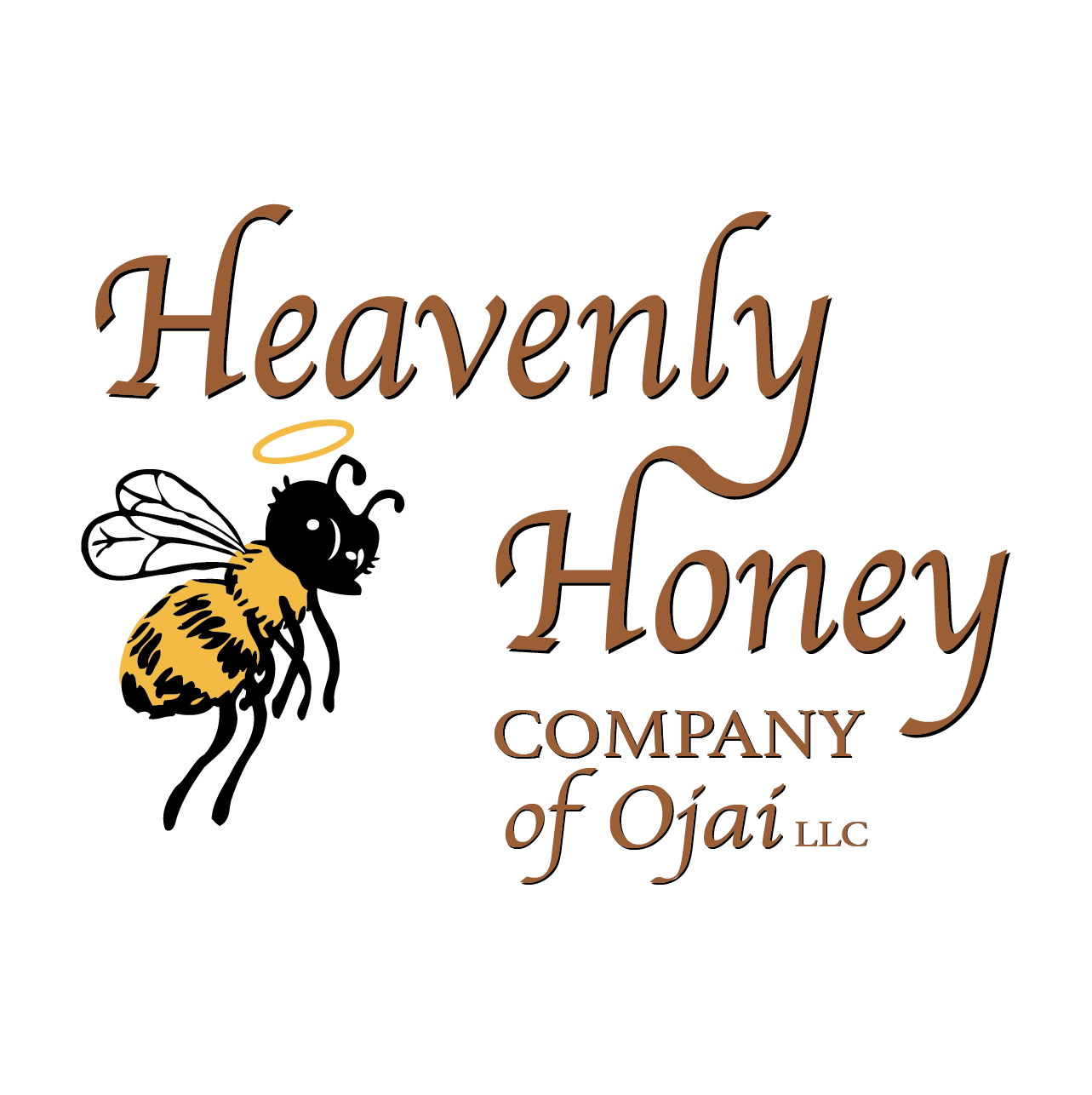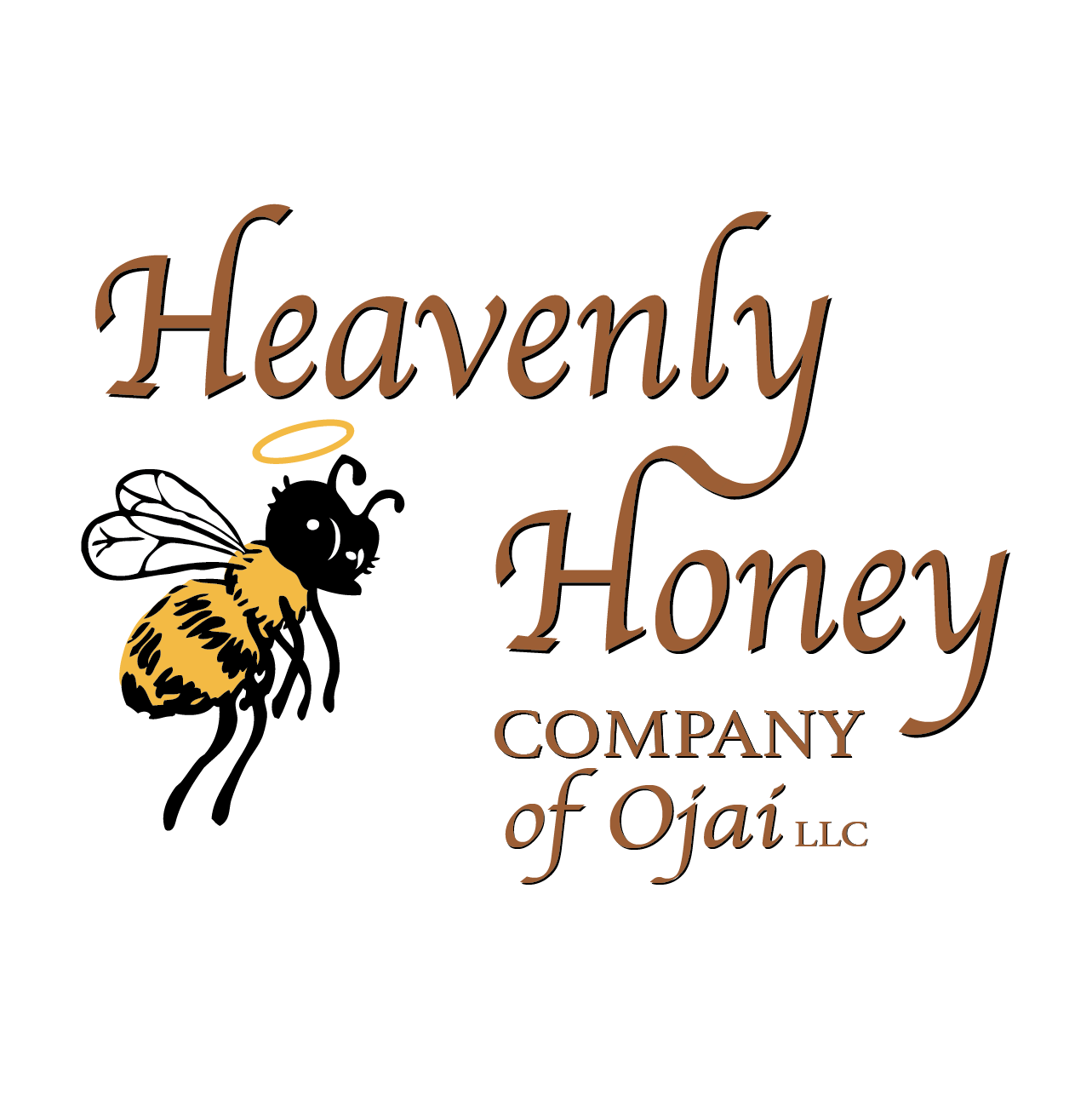
When you stroll through a farmers market or browse the honey aisle at grocery stores, you’ll likely encounter an array of honey options, including filtered and unfiltered varieties. This sweet, golden nectar, loved in the United States and beyond, not only adds a delightful touch to our meals but also brings many health benefits. But when choosing between filtered vs unfiltered honey, which is better?
Let’s delve into the world of honey, exploring the differences, benefits, and what you should know before making your next honey purchase.
Discover the Magic of Nature with Our Raw, Unfiltered Honey Selections! 🍯✨
Delight in the Unique Essence of Raw, Unfiltered Wildflower Honey:
Immerse yourself in the natural splendor of the Ojai hills and valleys with our locally sourced Raw Wildflower Honey. Each year brings a new, delightful variation, as the honey’s character is shaped by the diverse flowers in the unique micro-climates where our bees thrive.
Experience the intricate flavor profile of Wildflower Honey, marked by its nuanced and robust taste. Perfectly balanced in flavor intensity, it’s an ideal companion for your teas and toast, adding a touch of nature’s complexity to your daily rituals.
Savor the Sweetness of Raw, Unfiltered Orange Blossom Honey:
Embark on a sensory journey with our Raw Orange Blossom Honey, lovingly crafted in the heart of California’s central and southern regions. This honey captivates with its slightly sweeter essence and the delicate aroma of orange blossoms, offering a taste experience that transcends the ordinary.
Versatile and delightful, Orange Blossom Honey enhances your coffee, tea, and cereal, and even transforms simple dishes like boiled peas into a gourmet experience. Just a spoonful in boiling water, and you’ll taste the difference! An excellent alternative to white sugar, this honey is a crowd-pleaser and a must-try for every kitchen.
Begin Your Sweet Journey Today!
Now let’s jump into the Filtered vs Unfiltered Honey Comparison!
Understanding the Basics: Filtered Honey vs Unfiltered Honey
Before we explore the specifics of filtered and unfiltered honey, we must understand what sets them apart. Honey, in its natural state, contains traces of wax, pollen, and occasionally small parts of bees. The primary difference between filtered and unfiltered honey lies in how much of these natural elements are removed during processing.
- Filtered Honey: Filtered honey, as the name suggests, undergoes a filtering process to remove impurities such as bee parts, wax, and other debris. This process often involves high heat, affecting the honey’s natural properties. The result is a water clear, honey commonly found in grocery stores. This “super filtration” usually involves a diatomaceous earth filter, the result is honey that doesn’t crystallize – but also no longer contains the elements that make honey so good for you. It’s important to note that some filtered honey may contain added sweeteners like corn syrup, this is rarely reflected on the label.
- Unfiltered Honey: Unfiltered honey, often labeled as raw and unfiltered or simply raw unfiltered honey, is less processed. It may undergo minimal straining to remove large particles such as bee wings and large chunky bits of wax and propolis. Still, it retains most of its natural components, including pollen, propolis and small wax particles. This type of honey is closer to what you’d find directly in a beehive. It is often considered more natural and wholesome.
The Enhanced Benefits of Raw, Unfiltered Honey
Raw, unfiltered honey is celebrated for its health benefits attributed to its natural components. These benefits include:
- Rich in Antioxidants: Unfiltered honey is a powerhouse of antioxidants, including phenolic acids and flavonoids, known for their ability to combat oxidative stress and reduce the risk of chronic diseases.
- Natural Antibacterial and Antifungal Properties: It contains hydrogen peroxide and other components that give it antibacterial and antifungal properties, making it effective in wound healing and as a natural remedy for various infections.
- Soothing for Digestive Issues: Unfiltered honey can help soothe digestive issues, thanks to its prebiotic properties that nourish the good bacteria in the gut.
- Boosts Immune System: The presence of bee pollen in unfiltered honey helps boost the immune system, relieving seasonal allergies and enhancing overall health.
- Nutrient-rich: It retains a higher content of vitamins, minerals, and enzymes, which benefit overall health and wellness.
Looking for more benefits of unfiltered honey, read our article “10 Health Benefits of Raw Unfiltered honey“
The Role of Honey in Traditional and Modern Diets
Honey has been a part of human diets for thousands of years, valued for its sweetness and medicinal properties. It’s a versatile ingredient in modern times, used in everything from baking to beauty products. Understanding the types of honey, including organic and pure honey, is crucial for making informed choices about what we consume and use daily.
Speaking of roles, did you know that bees play a significant role of our food chain? Read more in our article “Pollination: The Bee’s Integral Link in Our Food Chain“
Honey Varieties and Their Unique Characteristics
While the discussion often centers around filtered vs unfiltered honey, the world of honey is vast and diverse, with each variety offering its unique flavor, color, and nutritional profile. These differences arise primarily from the types of flowers the bees visit to collect nectar. Let’s explore some of the most popular varieties, excluding Manuka honey, and understand what makes each special.
1. Clover Honey: Clover honey is one of the most widely available and well-known types of honey in the United States. It’s often recognized for its pleasingly mild, sweet, and floral flavor, making it a favorite among many honey enthusiasts. The color can range from very light to a medium amber hue. This variety is often praised for its versatility. It is commonly used as a natural sweetener in teas, baking, and cooking. Clover honey is also known for its antioxidant properties. However, it generally has a milder flavor and is less robust in health benefits than darker varieties.
2. Buckwheat Honey: Buckwheat honey significantly differs from clover honey in taste and appearance. It has a deep, dark brown color, and its flavor is robust, often described as brown sugar-like. This variety is packed with antioxidants and is known for its health benefits, including its ability to soothe sore throats and coughs. Due to its rich flavor, buckwheat honey is best used in recipes where its bold taste can complement other ingredients, such as marinades or a spread on hearty bread. We also like this variety in our Apple Spice Tea for a throat soothing tea; if you need something stronger add a bit of whisky for an instant hot toddy!
3. Orange Blossom Honey: Orange blossom honey, derived from the nectar of orange blossoms, is a fragrant, sweet, floral honey that does not taste like oranges. Its color ranges from light to mid amber. This variety is popular for its fresh, sweet taste with a hint of orange blossom scent, making it an excellent choice for sweetening fruit salads, teas, or baked goods. Orange blossom honey is also appreciated for its stress-relieving properties and is often used in aromatherapy.
4. Wildflower Honey: Wildflower honey, also known as polyfloral honey, is made from the nectar of various species of flowers or blossoms. The taste, color, and aroma can vary greatly depending on the mix of wildflowers the bees have foraged, making each batch of wildflower honey unique. This variety is often more complex in flavor compared to single-origin honeys. It can range from light to dark amber. Wildflower honey is a great all-purpose honey, suitable for cooking, baking, and as a table sweetener.
These are just a few of the honey varieties that we offer, explore our Honey Shop to discover more!
Choosing the Right Honey for You
When selecting between filtered and unfiltered honey, consider these factors:
- Health Goals: Raw, unfiltered honey is the superior choice if you’re seeking its health benefits.
- Taste and Texture Preferences: Unfiltered honey offers a more complete flavor profile with many varieties to choose from, each having their own unique flavor. Filtered honey tends to have a “homogenized” flavor because it is blended with honeys from many sources before it is filtered. There is rarely a variety of flavors available in filtered honey. Unfiltered honey is usually luxuriously thick while filtered honey is often thinner and runnier.
- Availability and Price: Raw, unfiltered honey is typically found at specialized proprietors such as our Honey Tasting Room, or at a farmer’s markets both being from local beekeepers and may be priced higher due to its much higher purity and less processed nature. Filtered honey is widely available in grocery stores and often cheaper due to its commodity-like handling by the mass packers.
The Importance of Sustainable Beekeeping
Sustainable beekeeping practices are crucial for the health of bee populations and the quality of honey produced. Supporting local beekeepers at farmer’s markets and purchasing honey online from reputable sources ensures beekeeping practices’ sustainability and bee colonies’ health.
Did you know that there is a dedicated day to bee’s? Read more about it in our article “World Bee Day: History, Bee Importance and Bee Conservation!“
Honey in The Kitchen
Honey’s versatility in the kitchen is unparalleled, making it a cherished ingredient among home cooks and professional chefs. Its natural sweetness, ability to retain moisture, and flavor-enhancing qualities lend themselves to various culinary applications. Let’s explore examples of how honey can be creatively used in various recipes, showcasing its adaptability and deliciousness.
1. Sweetening Beverages: Honey is a natural choice for sweetening beverages. A spoonful of clover or orange blossom honey can transform a cup of tea or coffee, adding a smooth, mellow sweetness. It’s also a popular addition to homemade lemonades or iced teas, where its subtle flavors can complement the drink without overpowering it.
2. Glazing Meats: Honey is an excellent meat glaze in savory dishes. For instance, a glaze made from orange blossom honey, soy sauce, and garlic can be brushed onto chicken or pork before roasting, creating a beautifully caramelized and flavorful crust. With its robust flavor, Buckwheat honey is ideal for bolder meats like beef or lamb.
3. Baking Delights: Honey’s role in baking is not just about sweetness; it adds moisture and depth of flavor. Wildflower honey can be used in baking bread, muffins, or cakes, contributing to a moist texture and a complex flavor profile. Honey can also be drizzled over baked goods like scones or biscuits for extra sweetness.
4. Salad Dressings: Honey is a key ingredient in many salad dressings. A simple vinaigrette made with olive oil, vinegar, mustard, and a dash of wild blackberry or pomegranate honey can elevate a basic salad to something special. Its ability to balance acidity makes it perfect for dressings.
5. Marinades: Honey is a natural tenderizer that imparts flavor in marinades. A marinade for grilled vegetables or tofu, incorporating honey, herbs, and citrus juice, can add a delightful sweetness and char when grilled.
6. Yogurt and Breakfast Bowls: Honey is a great addition to yogurt or breakfast bowls for a healthy start to the day. Drizzling orange blossom or Crystalled Sunflower with Organic Italian Lemon Oil honey over a bowl of yogurt, fresh fruits, and granola creates a delicious and nutritious breakfast.
7. Dessert Toppings: Honey is not just for cooking; it’s also a wonderful dessert topping. Drizzling honey over ice cream, especially a darker variety like buckwheat honey, adds a rich and intriguing flavor. It can also be used to sweeten fruit salads or as a topping for pancakes and waffles.
For more recipe ideas, check out our article “10 Honey Recipes: So Good, They’re Heavenly!“
Conclusion of Filtered vs Unfiltered Honey
There needs to be a clear winner in the debate of filtered honey vs. unfiltered honey, but it boils down to personal preference and intended use. Of course we choose raw, unfiltered honey! Both kinds of honey have their unique qualities and benefits. Remember to look for pure honey, to enjoy its natural goodness. Next time you’re at a farmers market or grocery store, consider these points and choose the honey that best suits your needs and taste buds. Happy honey hunting!
This family-friendly guide aims to comprehensively understand the differences between filtered and unfiltered honey, helping you make an informed choice on your next honey purchase. Remember, whether drizzled over your morning toast or used as a natural sweetener in your tea, honey in its various forms is a delightful addition to any family’s pantry.
Frequently Asked Questions
Is it safe to use unfiltered honey?
Yes, unfiltered honey is safe for most people. However, it should not be given to infants under one year due to the risk of botulism.
Is filtered or unfiltered honey better for you?
Unfiltered honey is generally considered better for health due to its higher content of natural nutrients and antioxidants.
What is the healthiest honey to eat?
The healthiest honey is typically raw and unfiltered, retaining most of its natural nutrients and beneficial properties.
Why do they filter honey?
Honey is filtered to remove the components that cause it to crystallize over time. There is a misconception that honey has gone bad when it crystallizes or “goes solid.” Actually, when honey crystallizes, that proves it is intact and hasn’t been super filtered. The simple answer is, crystallized honey doesn’t sell from the supermarket shelves, filtering either slows that process or stops it entirely. The downside is the filtering process also removes all the good things from honey.





